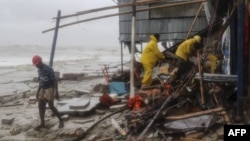Powerful Cyclone Roanu weakened Saturday afternoon after crashing into coastal Bangladesh, flooding towns and villages, triggering landslides and leaving at least 24 people dead across the region.
An estimated half-million people fled their homes for cyclone shelters following warnings from the authorities.
After the storm made landfall around noon local time, gusts reaching 90 kph uprooted trees, destroyed houses, and disrupted electricity and communications.
According to a statement issued Saturday evening by the disaster management authority in Dhaka, at least 24 people died across seven districts in southern Bangladesh.
Seven people died in Banskhali in Chittagong district after a surge in the sea breached dikes and flooded coastal villages. Three people, including a child, drowned on Hatiya Island after seawater flooded their village.
Mohammad Shahabuddin, an official with the Bangladesh Red Crescent Society’s Cyclone Preparedness Programme, said that a mother and her 13-year-old son died on Bangladesh’s largest island of Bhola.
"Although Roanu had its landfall around the noon, strong wind began blowing across Bhola Island since the early hours of the day. The mother and son died in Bhola after an uprooted tree fell on the house where they were sleeping around the dawn," Shahabuddin told VOA.
Wind damage, water surge
“A few hundreds of shops in Bhola have been damaged by the strong wind and water surge, which reached up to 2 meters," he added. "It’s a big blow to the local businesses.”
Airlines canceled all flights to and from Chittagong, a city of over 2.5 million people in the southeast, and authorities shut down sea and river ports Saturday, halting the ferries that millions of people in southern Bangladesh rely on for basic transportation.
On Friday, while Roanu was barreling through the Bay of Bengal, authorities in coastal villages used emergency warning systems to inform people of the threat.
“Using mobile microphones in all coastal districts, our officials sent across the warning about the cyclone. We mobilized forces and evacuated the people from the vulnerable coastal areas. We also restricted the movements of boats, barges and fishing trawlers since Friday,” Mesbah Uddin, Chittagong district’s chief administrator, told the local media.
Although Roanu had weakened and crossed over to India’s Mizoram state by late evening and water had receded in many coastal areas, most of those who took shelter in cyclone centers late Friday had not moved out by Saturday night.
“Heavy rains are likely to lash the region following Roanu," Uddin said. "It can trigger landslides apart from flooding certain areas. So, many people are likely to stay on in the cyclone centers for a few days."
Warning time
While many experts say that Bangladesh has improved its disaster preparedness in recent years, some coastal residents complained that they were not happy with the cyclone warning this time.
“The authorities announced that the cyclone would hit around noon Saturday. But gusty winds and the surge in the sea began almost 10 hours ago, beginning to wreak havoc in our island just after the midnight. Many got no time to move themselves to safety or secure their houses, shops ...,” Rashid Sadi, a fish trader in Tajumuddin, Bhola district, told VOA.
Officials said Bangladesh has built more than 4,000 cyclone centers across the south of the country. Experts say the decline in deaths and property damage from cyclones is mostly due to the construction of cyclone shelters and improved evacuation procedures.
Cyclone and sea surges hit Bangladesh every year.
In 2007, Cyclone Sidr wreaked havoc in Bangladesh, killing over 2,000 people.









